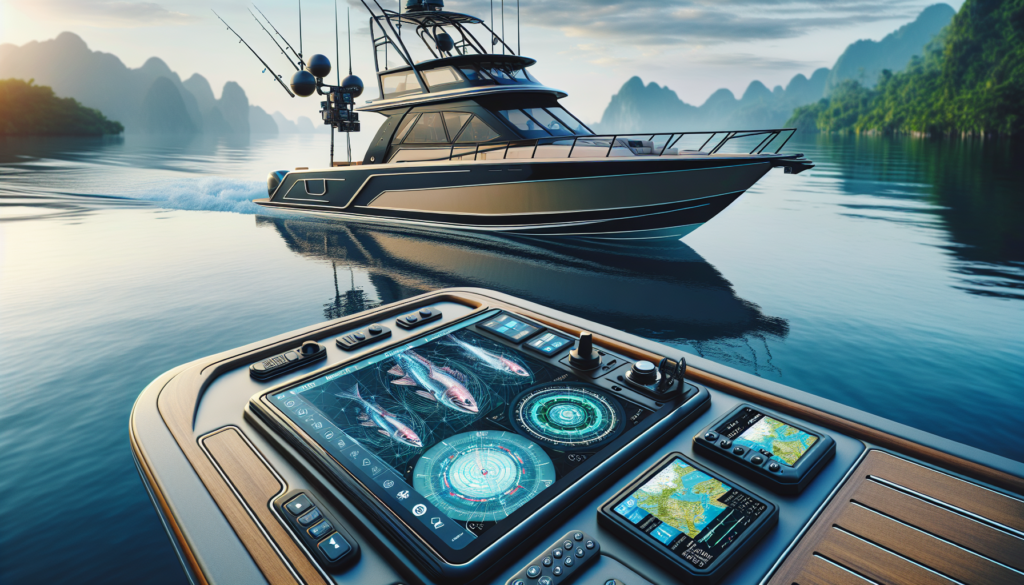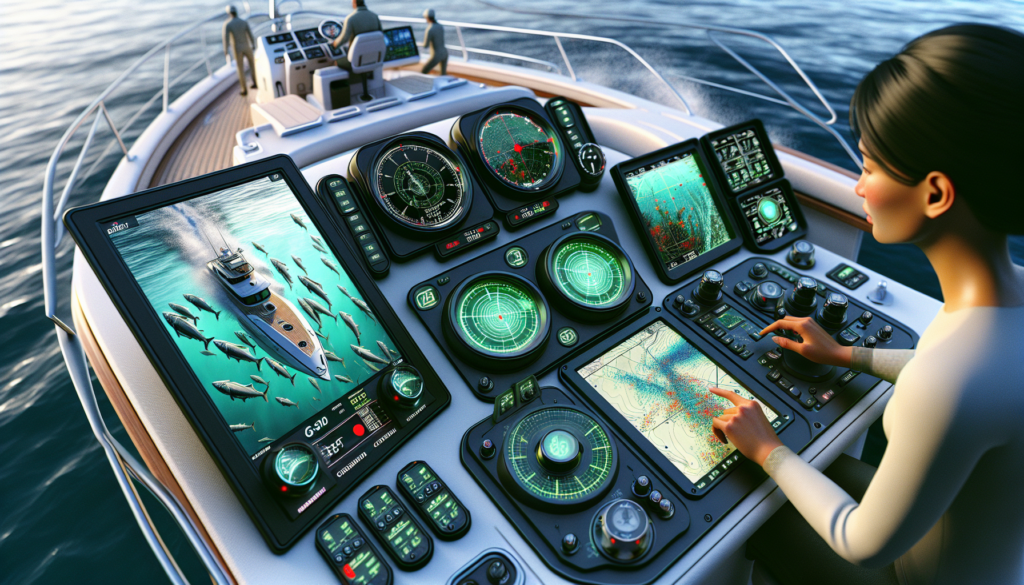If you’re a boating enthusiast looking to enhance your vessel’s navigation system, you’ll want to know about the most popular navigation electronics for boat customization. Whether you’re a seasoned sailor or just starting out, having the right equipment can make all the difference in ensuring a smooth and enjoyable trip on the water. With a wide range of options available, from advanced GPS systems to multifunction displays, this article will provide you with a comprehensive overview of the top navigation electronics that are highly sought after by boaters everywhere. Discover the latest technology and features that can take your boating experience to the next level.
GPS Systems
Fixed Mount GPS Systems
Fixed mount GPS systems are a popular choice among boaters who want a permanent navigation solution for their vessel. These systems are typically installed on the boat’s dashboard or helm, providing easy access and visibility. Fixed mount GPS systems offer a wide range of features, including accurate positioning, route planning, and waypoint tracking. They are designed to withstand the harsh marine environment, with waterproof and rugged construction. With a fixed mount GPS system, you can navigate confidently on the water and ensure a safe and enjoyable boating experience.
Handheld GPS Systems
For boaters who prefer a portable navigation solution, handheld GPS systems are the way to go. These compact devices offer the convenience of being able to take them anywhere on the boat or even off the boat. Handheld GPS systems are equipped with built-in antennas for reliable satellite reception and provide essential navigation functions such as position tracking, waypoint marking, and route planning. They are often used as backup devices or for boating activities like fishing or kayaking where portability is a priority. With a handheld GPS system, you have the flexibility to navigate both on land and on water.
Fishfinder GPS Combo Systems
Fishfinder GPS combo systems are a must-have for anglers who want to maximize their fishing experience. These systems combine the functionality of a GPS system with a built-in fishfinder, allowing you to not only navigate but also locate fish and underwater structures. Fishfinder GPS combo systems utilize sonar technology to display detailed images of the underwater environment, including fish arches, depth contours, and vegetation. With advanced features like CHIRP sonar and side imaging, these systems provide exceptional clarity and accuracy. Whether you are a recreational angler or a professional fisherman, a fishfinder GPS combo system is an invaluable tool for finding and catching fish.
Radar Systems
Open Array Radar Systems
Open array radar systems are the go-to choice for boaters who require long-range performance and high-definition radar imaging. These systems consist of a radar antenna with a rotating array of multiple radar elements. The rotating array allows for a 360-degree scanning capability, providing a comprehensive view of the surrounding area. Open array radar systems are known for their excellent target detection and high-resolution imaging, making them ideal for applications such as navigation in low visibility conditions, collision avoidance, and tracking weather patterns. With their advanced technology and reliable performance, open array radar systems ensure safety and peace of mind on the water.
Dome Radar Systems
Dome radar systems are compact and visually appealing radar solutions that offer a great balance between performance and aesthetics. These systems feature a radar antenna enclosed in a dome-shaped housing, providing a sleek and streamlined appearance. Dome radar systems are easy to install and maintain, making them a popular choice among boaters. While they may have a slightly shorter range than open array systems, dome radar systems still provide reliable target detection and accurate imaging. With their compact size and excellent performance, dome radar systems are suitable for a wide range of boats and boating applications.
Broadband Radar Systems
Broadband radar systems are the latest innovation in marine radar technology. These systems utilize advanced solid-state technology instead of traditional magnetron tubes, resulting in enhanced performance and improved energy efficiency. Broadband radar systems offer superior target separation and image clarity, allowing for better visibility and detection of small targets. These systems also have a near-instantaneous start-up time, eliminating the need for warm-up periods. Additionally, broadband radar systems are known for their low emissions, making them environmentally friendly. With their cutting-edge technology and impressive capabilities, broadband radar systems are a top choice for discerning boaters.

Chartplotters
Display Size Options
When choosing a chartplotter, one of the essential considerations is the display size. Chartplotters are available in a variety of sizes, ranging from compact screens to larger displays suitable for larger boats or multi-station installations. The display size determines the amount of information that can be shown at once, as well as the overall visibility and ease of use. Smaller screens are suitable for smaller boats or spaces with limited mounting options, while larger displays offer more screen real estate for enhanced visibility and user experience. Consider your boat’s size, mounting location, and personal preference when selecting the appropriate display size for your chartplotter.
Touchscreen vs Button Control
Chartplotters can be operated either through a touchscreen interface or with physical buttons. The choice between touchscreen and button control largely depends on personal preference and the specific boating environment. Touchscreen interfaces provide intuitive and user-friendly navigation, allowing for easy zooming, panning, and interacting with the various chartplotter functions. On the other hand, button control can be advantageous in rough sea conditions or when wearing gloves, as physical buttons provide tactile feedback and are easier to operate. Some chartplotters offer a hybrid option, combining touchscreen and button control for the best of both worlds. Consider your boating conditions and personal preferences when deciding on the control type for your chartplotter.
Built-in Wi-Fi and Bluetooth Connectivity
Many modern chartplotters now come with built-in Wi-Fi and Bluetooth connectivity, offering seamless integration with other devices and smart functionalities. Wi-Fi connectivity allows you to wirelessly connect your chartplotter to your smartphone, tablet, or computer, enabling easy software updates, data synchronization, and remote control. Bluetooth connectivity, on the other hand, enables wireless connection with compatible devices such as smartphones, headsets, and speakers, allowing for hands-free communication and audio streaming. Built-in Wi-Fi and Bluetooth connectivity provide convenience and versatility, enhancing the overall boating experience and expanding the chartplotter’s capabilities.
Marine VHF Radios
Fixed Mount VHF Radios
Fixed mount VHF radios are an essential communication tool for boaters, enabling reliable communication with other vessels, marinas, and emergency services. These radios are permanently installed on the boat and provide a dedicated means of communication. Fixed mount VHF radios offer a range of features, including channel scanning, weather alerts, and GPS integration. They are designed to withstand the marine environment, with waterproof and durable construction. With a fixed mount VHF radio, you can stay connected and ensure clear and effective communication while on the water.
Handheld VHF Radios
Handheld VHF radios offer the flexibility and portability needed for boating activities on the go. These compact devices can be carried anywhere on the boat or even off the boat, providing reliable communication wherever you are. Handheld VHF radios are equipped with built-in antennas for excellent signal reception and transmission range. They offer essential features such as channel monitoring, emergency alerts, and battery-saving modes. Handheld VHF radios are often used as backup devices or for activities such as dinghy sailing, paddleboarding, or fishing on small boats. Having a handheld VHF radio ensures safety and constant communication, even in emergency situations.
AIS and DSC Capabilities
Some VHF radios come with additional capabilities such as Automatic Identification System (AIS) and Digital Selective Calling (DSC). AIS allows for the automatic exchange of data between vessels, providing valuable information about other ships’ location, speed, and course. This information can help prevent collisions and improve situational awareness on the water. DSC, on the other hand, enables selective calling and distress signaling with the push of a button. DSC-capable VHF radios can transmit distress alerts with your boat’s position and identity, ensuring rapid response in emergency situations. AIS and DSC capabilities enhance safety and communication capabilities, making them valuable features to consider when choosing a VHF radio.

Sonar Systems
Traditional Sonar
Traditional sonar systems have long been a staple in boating, offering reliable depth soundings and fish-finding capabilities. These systems emit a single frequency sound wave that bounces off underwater objects and returns to the transducer, providing information about the depth and structure of the water column. Traditional sonar is known for its simplicity and affordability, making it accessible to boaters of all levels of experience. While it may not offer the same level of detail as more advanced sonar technologies, traditional sonar remains a popular choice for recreational boaters who need basic underwater information.
Down Imaging Sonar
Down imaging sonar systems take underwater imaging to the next level, offering a more detailed and realistic view of what’s beneath the surface. These systems utilize high-frequency sound waves to produce detailed images of the bottom structure and submerged objects. Down imaging sonar provides enhanced clarity and definition, allowing boaters to distinguish fish, vegetation, and underwater features with precision. This technology is especially useful for fishermen looking to identify fish-holding structures and select the most promising spots. With down imaging sonar, you can gain valuable insights into the underwater world and improve your fishing success.
Side Imaging Sonar
Side imaging sonar systems provide an even broader perspective of the underwater environment, offering a detailed view to the left and right of the boat. By emitting high-frequency sound waves and analyzing the returning echoes, side imaging sonar systems generate comprehensive images of the underwater terrain and objects. This technology allows boaters to see submerged structures, vegetation, and fish in incredible detail. Side imaging sonar is particularly useful for locating fish-holding structures and mapping out large areas quickly. Whether you are fishing, exploring, or navigating unfamiliar waters, side imaging sonar provides a valuable visual aid for better decision-making and situational awareness.
Autopilot Systems
Hydraulic Autopilot Systems
Hydraulic autopilot systems are designed to control the steering of the boat automatically, providing hands-free operation and precise navigation. These systems utilize hydraulic pumps and cylinders to adjust the boat’s rudder position, maintaining a steady course or following a pre-programmed route. Hydraulic autopilot systems offer excellent responsiveness and accuracy, ensuring optimal boat control even in challenging sea conditions. Whether you are cruising, fishing, or engaging in other boating activities, hydraulic autopilot systems relieve the strain on the helmsman and enhance overall comfort and safety on board.
Electromechanical Autopilot Systems
Electromechanical autopilot systems offer an alternative to hydraulic systems, utilizing electric motors and mechanical linkage to control the boat’s steering. These systems are known for their reliability and energy efficiency, providing precise and responsive steering control. Electromechanical autopilot systems are often chosen for smaller boats or situations where hydraulic components may not be feasible. They offer user-friendly operation and flexibility, allowing for easy installation and integration with other onboard electronics. With an electromechanical autopilot system, you can enjoy effortless navigation and concentrate on other aspects of the boating experience.
Networked Autopilot Systems
Networked autopilot systems take autopilot functionality to the next level, integrating with other onboard electronics to offer enhanced capabilities and convenience. These systems can be connected to GPS devices, chartplotters, and even mobile devices, allowing for advanced features such as route planning, waypoint navigation, and automatic course corrections. Networked autopilot systems provide seamless integration and easy control through a centralized interface, simplifying the navigation process and improving overall performance. Whether you are cruising long distances or navigating complex passages, a networked autopilot system offers advanced functionality and comprehensive control at your fingertips.

Marine Satellites
Satellite Phones
Satellite phones provide reliable communication capabilities in remote areas where cellular coverage is limited or unavailable. These portable devices utilize satellite technology to establish a connection, ensuring global reach and availability. Satellite phones are often used by boaters who venture into offshore waters or need a reliable communication method when sailing far away from the coastline. They offer voice and text messaging services, allowing boaters to stay connected with loved ones, emergency services, and fellow boaters. With a satellite phone, you can have peace of mind knowing that you have a reliable means of communication, no matter where your boating adventures take you.
Marine Satellite TV Systems
Marine satellite TV systems bring the comforts of home to your boat, allowing you to enjoy live TV programming and entertainment while on the water. These systems utilize satellite technology to receive TV signals and transmit them to your onboard television. Marine satellite TV systems offer access to a wide range of channels, including news, sports, movies, and more. Some systems even provide HD programming and DVR capabilities, ensuring a high-quality viewing experience. With a marine satellite TV system, you can relax and enjoy your favorite shows and movies, making your boating experience even more enjoyable and entertaining.
Marine Satellite Internet Systems
Marine satellite internet systems provide high-speed internet access on your boat, allowing you to stay connected and access online resources while at sea. These systems utilize satellite communication to establish a reliable internet connection, ensuring connectivity even in remote areas. Marine satellite internet systems offer fast data transfer rates, enabling activities such as web browsing, email communication, and streaming content. They are particularly useful for boaters who need internet access for work, navigation, or staying connected with friends and family. With a marine satellite internet system, you can enjoy the convenience and benefits of the internet, no matter where you are on the water.
Depth Sounders
Single Frequency Depth Sounders
Single frequency depth sounders are simple yet effective tools for measuring water depth. These sounders emit a single sound wave frequency and measure the time it takes for the wave to bounce back to the transducer, providing an accurate depth reading. Single frequency depth sounders are known for their affordability and straightforward operation, making them popular among recreational boaters. They are suitable for general boating activities and provide essential depth information for safe navigation in shallow or unfamiliar waters. Whether you are cruising, fishing, or enjoying water sports, a single frequency depth sounder is a valuable tool for ensuring navigational safety.
Dual Frequency Depth Sounders
Dual frequency depth sounders offer enhanced performance and versatility compared to single frequency models. These sounders emit two different sound wave frequencies simultaneously, providing a more detailed and comprehensive view of the underwater environment. The higher frequency provides better resolution for detecting small objects and fish, while the lower frequency provides greater depth penetration. Dual frequency depth sounders offer improved accuracy and better target separation, allowing boaters to identify underwater structures and fish-holding spots more effectively. Whether you are a serious angler or a boater who values detailed depth information, a dual frequency depth sounder is a worthwhile investment.
CHIRP Depth Sounders
CHIRP (Compressed High-Intensity Radar Pulse) depth sounders represent the latest advancement in sonar technology. Unlike traditional sounders that emit a single sound wave frequency, CHIRP sounders emit a continuous sweep of frequencies, providing an extensive range of depth information. This results in unparalleled clarity, definition, and target separation. CHIRP depth sounders excel at distinguishing between fish, structure, and bottom contour, allowing boaters to make precise decisions based on the most detailed information available. Whether you are a recreational boater or a professional angler, a CHIRP depth sounder delivers unrivaled performance and accuracy for a truly immersive underwater experience.

Compass Systems
Standard Magnetic Compass
A standard magnetic compass is an essential navigation tool that provides a reliable reference for determining direction. These compasses utilize a magnetic needle that aligns with the Earth’s magnetic field, indicating the boat’s heading. Standard magnetic compasses are simple and robust, requiring no external power source and being unaffected by electronic interference. They provide accurate headings even in challenging conditions, making them an excellent backup option or a primary compass for boats without advanced navigation systems. With a standard magnetic compass, you can navigate with confidence and maintain a clear sense of direction on the water.
Gyroscopic Compass
Gyroscopic compasses offer enhanced stability and accuracy compared to standard magnetic compasses. These compasses utilize a gyroscopic sensor that maintains a stable orientation regardless of the boat’s motion. Gyroscopic compasses are designed to counteract the effects of boat roll, pitch, and yaw, providing a steady and precise heading reference. This stability is particularly beneficial in rough sea conditions or when maneuvering at high speeds. Gyroscopic compasses offer advanced features such as automatic compensation for declination and the ability to display true and apparent headings. Whether you are a professional captain or a recreational boater, a gyroscopic compass ensures reliable and accurate heading information for safe and confident navigation.
Electromagnetic Compass
Electromagnetic compasses combine the best of both worlds by integrating magnetic and electronic sensors. These compasses utilize both magnetic readings and electronic stabilization to provide accurate and stable heading information. Electromagnetic compasses are immune to the effects of boat motion and external magnetic interference, ensuring reliable and consistent performance. They offer user-friendly features such as digital displays, automatic calibration, and integration with other navigation electronics. Electromagnetic compasses are an excellent choice for boaters who value accuracy, stability, and convenience in their navigation system.
Marine Cameras
Thermal Imaging Cameras
Thermal imaging cameras are valuable tools for boaters who want to enhance their situational awareness and safety on the water. These cameras utilize infrared technology to detect heat signatures and convert them into clear images, even in total darkness or adverse weather conditions. Thermal imaging cameras can display the heat signatures of other vessels, navigational aids, and hazards, allowing boaters to spot potential dangers from a distance. They are particularly useful for night navigation, search and rescue operations, and detecting hidden obstacles. With a thermal imaging camera, you can gain a powerful advantage in terms of safety and navigation, ensuring a secure and enjoyable boating experience.
Underwater Cameras
Underwater cameras provide a fascinating glimpse into the underwater world, allowing boaters to explore and capture memorable moments beneath the surface. These cameras are specially designed to withstand the harsh marine environment, with rugged and waterproof construction. Underwater cameras offer high-resolution imaging, enabling boaters to capture detailed pictures and videos of marine life, underwater landscapes, and their own boating adventures. Whether you are snorkeling, diving, or simply curious about what lies beneath your boat, an underwater camera adds a new dimension to your boating experience and allows you to share your discoveries with others.
Multi-Sensor Camera Systems
Multi-sensor camera systems combine the capabilities of different camera types into a single unit, offering comprehensive coverage and versatility. These systems typically combine visible light cameras, thermal imaging cameras, and other specialized sensors into a single compact housing. Multi-sensor camera systems provide a complete view of the boat’s surroundings, allowing boaters to monitor multiple areas simultaneously. They offer advanced features such as automated video tracking, customizable alarm zones, and seamless integration with other onboard electronics. Whether you want enhanced security, improved navigation, or better situational awareness, a multi-sensor camera system is a valuable investment for your boat.
In conclusion, there is a wide range of navigation electronics available for boat customization, each offering unique features and capabilities. Whether you are looking for a GPS system, radar system, chartplotter, VHF radio, sonar system, autopilot system, satellite system, depth sounder, compass system, or camera system, there is a solution to suit your needs. Consider the specific requirements of your boating activities, the size of your vessel, and your personal preferences when selecting the most suitable navigation electronics for your boat. With the right equipment onboard, you can navigate with confidence, stay connected, and enhance your overall boating experience.


